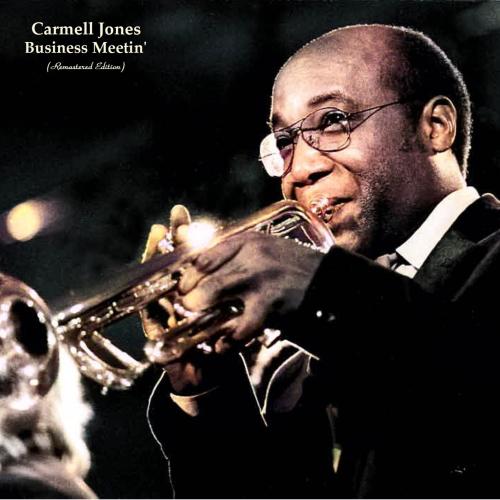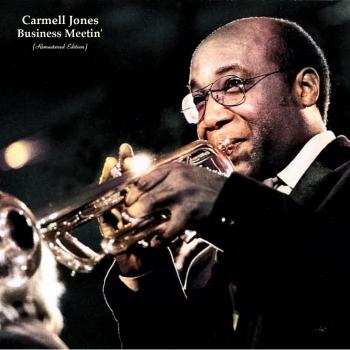
Business Meetin' (Remastered Edition) Carmell Jones
Album Info
Album Veröffentlichung:
1962
HRA-Veröffentlichung:
13.01.2023
Das Album enthält Albumcover
Entschuldigen Sie bitte!
Sehr geehrter HIGHRESAUDIO Besucher,
leider kann das Album zurzeit aufgrund von Länder- und Lizenzbeschränkungen nicht gekauft werden oder uns liegt der offizielle Veröffentlichungstermin für Ihr Land noch nicht vor. Wir aktualisieren unsere Veröffentlichungstermine ein- bis zweimal die Woche. Bitte schauen Sie ab und zu mal wieder rein.
Wir empfehlen Ihnen das Album auf Ihre Merkliste zu setzen.
Wir bedanken uns für Ihr Verständnis und Ihre Geduld.
Ihr, HIGHRESAUDIO
- 1 Business Meetin' (Remastered Edition) 04:51
- 2 That's Good (Remastered Edition) 06:05
- 3 Stella By Starlight (Remastered Edition) 02:34
- 4 Suearl (Remastered Edition) 07:07
- 5 Hip Trolley (Remastered Edition) 05:23
- 6 Toddler (Remastered Edition) 03:53
- 7 Beautiful Love (Remastered Edition) 05:38
- 8 Cherokee (Remastered Edition) 03:55
Info zu Business Meetin' (Remastered Edition)
When 26-year-old Carmell Jones left his native Kansas for California in August 1960, he made an immediate impact on the high-calibre West Coast jazz scene. Snapped up exclusively by Pacific Jazz, he recorded his first album as a leader, The Remarkable Carmell Jones, the following June.
Using much the same lineup as the celebrated Harold Land-Red Mitchell quintet, it was a stellar entrance for the young trumpeter, whose classy tone, ideas and commanding style recalled Clifford Brown. Land, on tenor, was another inspiration and they made a formidable pairing, but Brownie remained Joness primary reference, amply demonstrated throughout his leader debut, particularly on his feature, Come Rain or Come Shine, and on Full Moon and Empty Arms. It was bop with a joyous, West Coast accent, grounded in Joness lyrical assurance, Lands maturity and the solid virtues of pianist Frank Strazzeri, bassist Gary Peacock and drummer Leon Petties.
The second album, Business Meetin, used the same quintet, with Donald Dean in for Petties, and a nonet arranged by Gerald Wilson, including a saxophone section, which elicited an ideally simpatico response from Jones. Both these albums amply demonstrate why musicians were unanimous in their praise of this gifted young trumpeter and his sudden rise to national prominence.
Carmell Jones, trumpet
Bud Shank, alto saxophone
Clifford Scott, alto saxophone
Harold Land, tenor saxophone
Wilbur Brown, tenor saxophone
Don Rafell, baritone saxophone
Frank Strazzeri, piano
Gary Peacock, double bass
Leroy Vinnegar, double bass
Donald Dean, drums
Leon Petties, drums
Ron Jefferson, drums
Gerald Wilson, arrangements
Digitally remastered
Carmell William Jones
born July 19, 1936, was raised in Kansas City/ Kansas. His unusual Christian name comes from a Spanish word meaning ‘song’. Actually, he´s got some Spanish and some Red Indian blood. He always wanted a trumpet as a small boy. Although his parents were poor, they were badly paid teachers in Kansas City, they managed to enable Carmell music lessons: piano lessons started at age five, the trumpet lessons started at age seven. His father, a professional drummer once (Carmell used to play around on his kit), hoped he would play the sax and was pretty upset when he held out for a trumpet. When Carmell was eleven his mother scraped together the money to buy him a second-hand cornet for Christmas. He joined the school bands and it was while he was playing in one of the marching bands that he discovered jazz on the radio. His father was even more annoyed when Carmell declared that he intended to become a professional musician. Mr. Jones had plans for his son to go into engineering ... but he respected that Carmell had a mind and will of his own and encouraged him to study music seriously.
He also only 7 years old when he played with saxophonist NATHAN DAVIS for the first time. They are old buddies. Both are from Kansas City and spent the most important years of their musical and human education together, their entire adolescence. Both have played in the same Junior and Senior Highschool-Band when they were youngsters. Carmell graduated from High School in 1954. At university, when Nathan was still blowing trombone (!), he organized Jazz concerts all over Kansas City and Carmell was his favorite trumpet player. Because there was no work at home during that time, Carmell joined the U.S. Air Force, spending four years with the 501st Air Force Band at the Hickham Air Force Base in Hawaii, where he played with BILLIE HOLIDAY, and led his own quintet.
So Carmell and Nathan were separated when they joined the Army and then lost sight of each other. After his discharge, Carmell returned home and enrolled at the University of Kansas, intending to take a music degree, majoring in music education and trumpet.
In 1959 he took part in the annual collegiate jazz festival at Notre Dame, Indiana.
The antiquated teaching methods at University frustrated him so much that, after two years, he quit and started working as a steward (another source says he worked as a railway porter) on sleeping cars between Kansas City and Chicago.
In Spring 1960 Carmell, played at a club called 'Mardi Gras' in Kansas City in the band of pianist FRANK SMITH - together with alto saxophonist and Blues singer "CLEANHEAD" EDDIE VISON. He also led a group in Kansas City.
After being well reviewed by the German Jazz critic Joachim-Ernst Berendt (who had heard Jones while in Kansas City in 1960) he moved to California in the same year, working as a studio musician.
An excellent hard bop trumpeter, Carmell Jones would probably have been much better-known today if he had not moved to Europe in the mid-’60s at the height of his career. After military service and two years at the University of Kansas, Carmell Jones led a band in Kansas City (1959). The next year, he moved to Los Angeles where he recorded a couple of albums as a leader for Pacific Jazz and made records with Bud Shank, Harold Land, Curtis Amy, and most significantly Gerald Wilson’s Orchestra (1961-1963). Jones toured with Horace Silver for a year (1964-1965), recording the original version of “Song for My Father” with Silver before moving to Berlin. Although quite active in Europe, Carmell Jones was largely forgotten by the time he moved back to Kansas City in 1980; however, a 1982 album for Revelation helped remind a few listeners how good he still was. ~ Scott Yanow
Dieses Album enthält kein Booklet










